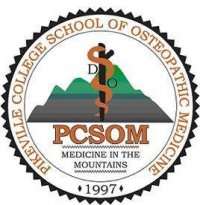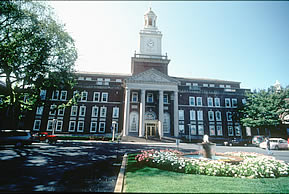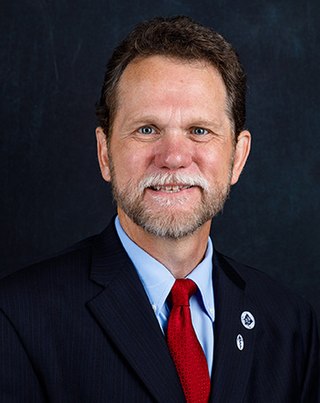
Osteopathy is a pseudoscientific system of alternative medicine that emphasizes physical manipulation of the body's muscle tissue and bones. In most countries, practitioners of osteopathy are not medically trained and are referred to as osteopaths.

In Greek mythology, the Rod of Asclepius, also known as the Staff of Aesculapius and as the asklepian, is a serpent-entwined rod wielded by the Greek god Asclepius, a deity associated with healing and medicine. In modern times, it is the predominant symbol for medicine and health care, although it is sometimes confused with the similar caduceus, which has two snakes and a pair of wings.
Osteopathic medicine is a branch of the medical profession in the United States that promotes the practice of science-based medicine, often referred to in this context as allopathic medicine, with a set of philosophy and principles set by its earlier form, osteopathy. Osteopathic physicians (DOs) are graduates of American osteopathic medical colleges and are licensed to practice the full scope of medicine and surgery in all 50 US states. The field is distinct from osteopathic practices offered in nations outside of the U.S., whose practitioners are generally not considered part of core medical staff nor of medicine itself, but rather are alternative medicine practitioners. The other major branch of medicine in the United States is referred to by practitioners of osteopathic medicine as allopathic medicine.

The American College of Emergency Physicians (ACEP) is a professional organization of emergency medicine physicians in the United States. ACEP publishes the Annals of Emergency Medicine and the Journal of the American College of Emergency Physicians Open.

An emergency physician is a physician who works in an emergency department to care for ill patients. The emergency physician specializes in advanced cardiac life support, resuscitation, trauma care such as fractures and soft tissue injuries, and management of other life-threatening situations.
Most physicians in the United States hold either the Doctor of Medicine degree (MD) or the Doctor of Osteopathic Medicine degree (DO). Institutions awarding the MD are accredited by the Liaison Committee on Medical Education (LCME). Institutions awarding the DO are accredited by the Commission on Osteopathic College Accreditation (COCA). The World Directory of Medical Schools lists both LCME accredited MD programs and COCA accredited DO programs as US medical schools. Foreign-trained osteopaths do not hold DO degrees and are not recognized as physicians in the United States or in other jurisdictions.
The American Board of Physician Specialties (ABPS), the official certifying body for the American Association of Physician Specialists (AAPS) is a non-profit umbrella organization for sixteen medical specialty boards that certifies and re-certifies physicians in fourteen medical specialties in the United States and Canada. It is one of three certifying bodies in the United States in addition to the American Board of Medical Specialties, and American Osteopathic Association Bureau of Osteopathic Specialists. The ABPS oversees Doctor of Medicine (M.D.) and Doctor of Osteopathic Medicine (D.O.) certification in the United States. The ABPS assists its Member Boards in developing and implementing educational and professional standards to evaluate and certify physician specialists. It is recognized by the U.S. Department of Labor as well as the Centers for Medicare and Medicaid Services (CMS).
The American Academy of Disaster Medicine (AADM) was founded in 2006 to promote the science and art of disaster healthcare. It is one of the newest medical organizations in the world. On October 18, 2007 the American Academy of Disaster Medicine was also the first medical organization in history to fulfill a Presidential mandate that called for the formal organization of disaster healthcare. AADM was instrumental in establishing disaster medicine as a recognized medical specialty; a certifying board, the American Board of Disaster Medicine was approved by the American Board of Physician Specialties in 2004. The Academy's headquarters is in Tampa, Florida.
Doctor of Osteopathic Medicine is a medical degree conferred by the 38 osteopathic medical schools in the United States. DO and Doctor of Medicine (MD) degrees are equivalent: a DO graduate may become licensed as a physician or surgeon and thus have full medical and surgical practicing rights in all 50 US states. As of 2021, there were 168,701 osteopathic physicians and medical students in DO programs across the United States. Osteopathic medicine emerged historically from osteopathy, but has become a distinct profession.

The American College of Osteopathic Family Physicians (ACOFP) is a professional association and a medical specialty college in the United States. Its membership consists of osteopathic physicians who practice family medicine, residents and medical students. ACOFP is closely affiliated with the American Osteopathic Association and is the osteopathic equivalent of the American Academy of Family Physicians. Much of the association's activities involve addressing the chronic shortage of family practitioners in the United States. It is responsible for setting the standards for the inspection of osteopathic graduate medical education programs in family practice.

The American Osteopathic Board of Emergency Medicine (AOBEM) is an organization that provides board certification to qualified Doctors of Osteopathic Medicine who specialize in the medical and surgical treatment of acutely ill patients with advanced cardiac life support, trauma, and the management of other life-threatening medical issues. The AOBEM is one of 18 medical specialty certifying boards of the American Osteopathic Association Bureau of Osteopathic Specialists approved by the American Osteopathic Association (AOA).
The American College of Osteopathic Emergency Physicians (ACOEP) is a professional organization of emergency medicine physicians. It was founded in 1975. Active membership is open only to osteopathic (D.O.) medical physicians who have practiced emergency medicine for the past three years and/or have completed an emergency medicine residency approved by the American Osteopathic Association (AOA) or Accreditation Council for Graduate Medical Education (ACGME). Fellows use the designation FACOEP. As of November 2017, ACOEP had over 5,000 members.
In 2006, hospice and palliative medicine was officially recognized by the American Board of Medical Specialties, and is co-sponsored by the American Boards of

The University of Pikeville - Kentucky College of Osteopathic Medicine (UP-KYCOM) is the medical school of University of Pikeville, a private university affiliated with the Presbyterian Church (USA) and located in Pikeville, Kentucky. UP-KYCOM was established in 1997, grants the Doctor of Osteopathic Medicine degree. It is accredited by the Commission on Osteopathic College Accreditation (COCA) and the Commission on Colleges of the Southern Association of Colleges and Schools.

The American Osteopathic Board of Family Physicians (AOBFP) is an organization that provides board certification to qualified osteopathic physicians (D.O.) who specialize in delivering comprehensive primary care for patients of all ages, genders, and addressing all parts of the body. The board is one 18 medical specialty certifying boards of the American Osteopathic Association Bureau of Osteopathic Specialists approved by the American Osteopathic Association (AOA), and was established in 1972. As of April 2012, 6,344 osteopathic family physicians held active certification with the AOBFP.

Reading Hospital is a 738-bed non-profit teaching hospital located in West Reading, Pennsylvania. The hospital was established in 1867 and is the anchor institution of Tower Health.

Peter Alan Bell, DO, MBA, FACOEP-dist, FACEP is an American osteopathic physician. He is the current Vice Provost and Dean at Baptist College of Health Sciences, now known as Baptist Health Sciences University in Memphis, TN. Additionally, Bell is nationally known for his continued work on health policy reform and the impact of health policy on the medical profession. Finally, Bell has served as president of the Ohio Osteopathic Association (OOA) and the National President of The American College of Osteopathic Emergency Physicians (ACOEP).
California Health Sciences University (CHSU) is a private, for-profit university located in Clovis, in the U.S. state of California. Founded in 2012, the school operates three academic programs, two of which offer doctoral degrees in pharmacy and osteopathic medicine, and the third offers a masters degree in science. Graduates of the College of Pharmacy (COP) will receive the Doctor of Pharmacy (Pharm D) degree, graduates of the College of Osteopathic Medicine (COM) will receive the Doctor of Osteopathic Medicine (DO) degree, and graduates of the College of Biosciences and Health Professions (CBHP) will receive the Masters of Science in Biomedical Sciences (MSBS) degree. The College of Osteopathic Medicine is fully pre-accredited by the American Osteopathic Association's (AOA) Commission on Osteopathic College Accreditation (COCA). The college is accredited by the Western Association of Schools and Colleges (WASC) Senior College and University Commission and has approval to operate from the Bureau of Private Postsecondary Education (BPPE).

The Western Journal of Emergency Medicine: Integrating Emergency Care with Population Health, (WestJEM) is a bimonthly peer-reviewed, fully open access medical journal.










